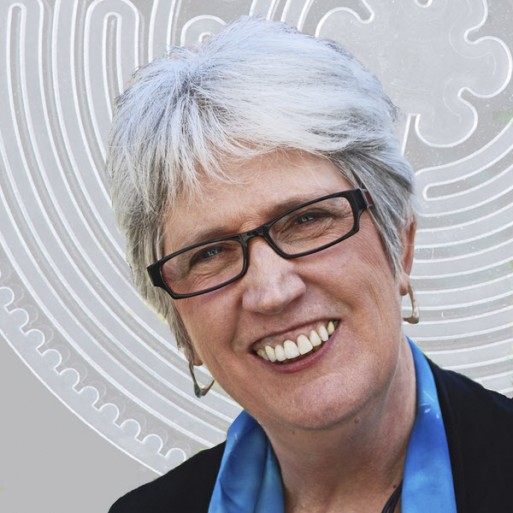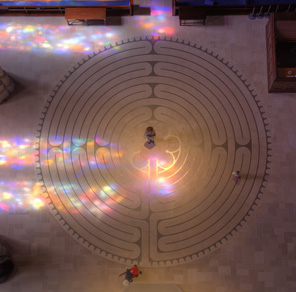Reverend Lauren Artress is an inspiring Canon at Grace Cathedral in San Francisco, and a spiritual pioneer in the Labyrinth Movement. She has written many books on the labyrinth and holds workshops around the world. Lauren’s labyrinth-based nonprofit, Veriditas, has the mission to “pepper the world with labyrinths.”
Greer: Let’s start very simply; what is a labyrinth?
Lauren: A labyrinth is a design, oriented flat on the floor, that is usually a 40-foot circular pattern. There is one path that leads from the outer edge in a very circuitous way into a stabilized center. And the walker, the person walking the labyrinth, walks the path—simply that.
A labyrinth is not a maze; a maze is a cognitive puzzle designed for you to lose your way. A labyrinth is a path that you follow to find your way. They are diametrically opposed. There is one theory that when we became so oriented to linear thinking, mazes were a way to destroy labyrinths. All you have to do is remove one path and make it into a puzzle so that people lose their way. Mazes are about 600 years old, whereas labyrinths are about 4-5,ooo years old.
Greer: What is the process of walking a labyrinth like?
Lauren: Usually we think of the labyrinth as having three different stages. Sometimes people describe it as four — I often describe it as the “Three R’s:” releasing, receiving, returning. If you are dealing with four stages, the first is remembering – remembering that you are blessed, that you are loved. Often as people wait to enter a labyrinth they do some preparation, which is where remembering can be very helpful.
Once you walk in and cross the threshold into the labyrinth, you find your natural pace. This is an important thing to do when you are walking that first part of the labyrinth. Find your natural pace. It will change throughout the walk.
Often people start a little quicker, then slow down once they find the pace their body wants to go, not the pace their mind thinks they should go. Then you can more easily enter your own flow and there is usually a releasing process that happens; that would be, the first “R.”
There is a deeper place that we live if we allow ourselves to come there.
You are letting go; you are shedding…letting go of everyday thoughts, and allowing yourself to come home to yourself. There is a deeper place that we live if we allow ourselves to come there.
The second stage starts as you arrive at the center. You have released; you have shed; you have emptied; you have made space in your being to receive. That’s the second “R,” receiving. At that point, you can sit, or stand, and stay as long as you want in the center. Often there are many people in the center.
Then, when you are ready, you walk the return path back out. And that’s the third “R,” returning. Often people reclaim something, or they come to a resolution about how they want to live their lives.
People might just use that third stage for reflection, as they walk back out the same path. There is an integration to it, a sense of strengthening as you walk back out of a labyrinth.
This is a thumbnail sketch. These stages can happen at anywhere in a labyrinth, you can receive anywhere; you can release anywhere and often — especially if people are dealing with grief, a time of tears — you really let yourself feel what you need to feel. This is a time and place to do just that.
Greer: Can you tell me a bit more about how walking a labyrinth can help with the grieving process?
Lauren: The mind is focused on following the meditative pattern of a labyrinth during the walk. This allows other parts of our being to open up — the imagination and the intuitive sense of our nature. With grief specifically — the way I understand and experience my own grief — it is like a well that fills up. When it fills, then you need to release.
The labyrinth is like coming home to yourself. You sink into yourself, and often when the well is filled inside, then the labyrinth becomes a safe place to feel those feelings. People weep and cry in the labyrinth, and we just encourage people to stay with it because the well will get dry again. Then people go on about their lives. Then the well fills up again, and that is a great time to go back to a labyrinth.
Each labyrinth walk is different, even if you walk it a second time right away. It is that sense that you can’t step into the same river twice. But that is different with someone who is grieving, because there is a deep river there, and you are stepping back into that same river.
So a person who is grieving might want to walk two or three times until they feel that the well has been dried and drained. It could be one or two walks, or it could be staying and not rushing when you come to the center.
Some people in grief use it regularly. They might make a practice of it for themselves. They might go every Monday morning or every Friday after their work week. Moving it into a regular schedule is really helpful.
One of the major uses of a labyrinth, besides active grieving, is for family members when their loved one is in a hospital or in hospice. We have trained facilitators for just that. A family might walk the labyrinth together as they tend to their loved one as that person makes a transition. I don’t mean at the moment of, but days before, as family gathers at the bedside.
Of course, the main metaphor is that we are all walking this path together. We are in different stages, some of us are ending the journey, some of us beginning, most of us are in the middle…on the way into the middle.
Walking the labyrinth is a great nonverbal activity. It goes beyond words. Words are where we get in trouble. But when we do an activity together that is reflective, that is meditative, you are alone together in that process. It can be very helpful to build bonds between people, built in a meditative knowingness. Of course, the main metaphor is that we are all walking this path together. We are in different stages, some of us are ending the journey, some of us beginning, most of us are in the middle…on the way into the middle.
Please join us next week for part two of our interview with Lauren.

 How Can a Labyrinth Help in the Grieving Process? An Interview with Lauren Artress, Part One
How Can a Labyrinth Help in the Grieving Process? An Interview with Lauren Artress, Part One






 “Hands Up to the Sky” by Michael Franti & Spearhead
“Hands Up to the Sky” by Michael Franti & Spearhead
 Coping With Election Grief
Coping With Election Grief
















This helpful. On Sunday I’m joining a friend to walk our labyrinth to help us mourn. I like the metaphor of a well filling up because that is how I feel. Everytime I think or see a picture of my cousin, the tears come. I’m not sure how we’ll prepare for our walk.
Report this comment
Hi Sue,
Please let us know about your experience so we can share it with our readers.
Thanks!!
Report this comment
Hi. We are a charitable organization and we are thinking of publishing a hand size labyrinth to help our caregivers who lost their loved ones. Wonder if there is a hand-size/others labyrinth where we can purchased for our caregivers. And how to use it effectively for all religions/faiths/atheists.
Thanks.
Report this comment
Lee, I just came across this website and saw your question about hand held labyrinths. A simple google search will offer many options. That is how I found mine, Additionally, there is a free online app called “Labyrinth Journey” by Mount Mojo. It is available for the iPhone and the Android. Best of luck.
Report this comment
As a newly (Veriditas) trained labyrinth facilitator who also focuses in the area of grief, I found this interview very helpful. The labyrinth is quite versatile in it’s use. I did a laughter walk (as I am a Laughter Yoga Teacher) and a gratitude walk for all the blessings I have received during a particular week. Yes, we all experience grief differently. Walking the path leads us to transform our grief into love. I look forward to reading part two. Thank you.
Report this comment